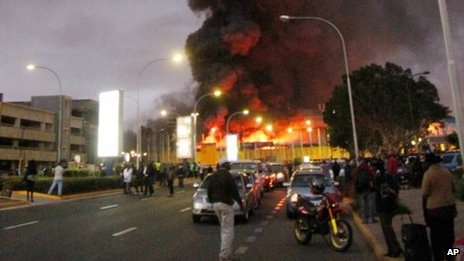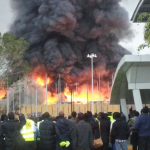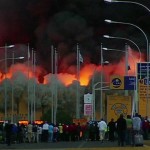A huge fire has ravaged the main international airport in the Kenyan capital, Nairobi.
Jomo Kenyatta International Airport (JKIA) – a key regional hub – has been closed, passengers evacuated and incoming flights diverted.
The fire is now said to have been contained but there have been reports that it took emergency services a long time to respond.
Images from the scene showed flames leaping from one of the main buildings.
There have been no reports of any casualties and the cause of the fire is not clear.
Jomo Kenyatta International Airport is the regional hub for East Africa, with many long-distance flights landing there to connect to countries across the region.
The airport is the main gateway for European tourists – and it is now the height of the tourist season – and is also crucial for the country’s key flower export industry, so the fire could have a huge economic impact, says the BBC’s Emmanuel Igunza at the scene.
Shares in Kenya Airways fell in early trading on Wednesday.
Despite earlier official statements that the airport had been closed indefinitely, presidential spokesman Manoah Esipisu said domestic flights and international cargo flights would resume later on Wednesday.
‘Water shortage’
The cabinet secretary for transport, Michael Kamau, earlier described the fire as “very severe”, and although it is contained firefighters are still battling the flames.
Dark smoke could be seen billowing into the sky across much of Nairobi as the fire – which began at approximately 04:30 local time (01:30 GMT) – took hold.
Passengers arriving on international flights – some still in their seats – reported hearing explosions from the terminal building.
Fire engines did not begin to arrive for one to two hours after the fire broke out, witnesses told our correspondent – by which time the blaze was ravaging the cavernous and ageing arrivals hall.
Kenya’s police and fire units are poorly resourced and the state response was supplemented by the Red Cross and private security firms including – airport authorities said – the British multinational company G4S.
One witness told AP news agency she had seen soldiers and police trying to douse the inferno using buckets of water.
Witnesses said traffic jams prevented emergency vehicles getting through, leading the interior ministry to appeal to cars to get out of their way.
Shocked would-be passengers stood outside the airport, bags in hand, watching the blaze.
The cabinet secretary for transport, Michael Kamau, earlier described the fire as “very severe”, and although it is contained firefighters are still battling the flames.
Dark smoke could be seen billowing into the sky across much of Nairobi as the fire – which began at approximately 04:30 local time (01:30 GMT) – took hold.
Passengers arriving on international flights – some still in their seats – reported hearing explosions from the terminal building.
Fire engines did not begin to arrive for one to two hours after the fire broke out, witnesses told our correspondent – by which time the blaze was ravaging the cavernous and ageing arrivals hall.
Kenya’s police and fire units are poorly resourced and the state response was supplemented by the Red Cross and private security firms including – airport authorities said – the British multinational company G4S.
One witness told AP news agency she had seen soldiers and police trying to douse the inferno using buckets of water.
Witnesses said traffic jams prevented emergency vehicles getting through, leading the interior ministry to appeal to cars to get out of their way.
Shocked would-be passengers stood outside the airport, bags in hand, watching the blaze.
Nairobi resident Barry Fisher – who had hoped to travel to Ethiopia on Wednesday – described the scene as chaotic.
“There was no-one stopping any traffic going to the road to the airport,” he told AP news agency.
“A number of fire trucks and ambulances were trying to negotiate their way through the lane… They were trying to weave their way through a solid two lanes of cars.”
American student Emily Mosites was in the airport trying to get a flight to Kisumu when the fire broke out.
“There was no emergency direction on leaving – I just stood there watching the fire. There were no officials to tell anyone what to do.
“I wasn’t told whether or not there were any flights departing. So I thought this was insane and decided to leave.”





The government also admitted that firefighters had run “dangerously low on water” and water tankers had had to be sent to bolster supplies.
Interior Minister Joseph Ole Lenku said the airport had “lost the arrival areas and a number of offices have been gutted”.
“We have heightened security to make sure people are safe…. We will make sure we establish the true cause of the fire,” he told journalists.
Cabinet secretary for transport Michael Kamau earlier said the blaze began in the immigration zone, which he said was deep inside the affected building, making it difficult for firefighters to reach.
He paid tribute to the work of the emergency services.
President Uhuru Kenyatta – whose father the airport was named after – has toured the burning building to see the damage.
Incoming flights have been diverted to regional airports and to Mombasa, where the BBC’s Odhiambo Joseph said there were chaotic scenes with hundreds of passengers stranded.
Correspondents say authorities will be keen to get the airport fully operational as soon as possible – and an airport authority committee is looking at how to do so.
The blaze comes two days after aircraft were delayed for several hours after the failure of a hydrant needed for refuelling planes at the airport.
Jomo Kenyatta Airport
- Busiest airport in east and central Africa, and seventh busiest in Africa
- Handles six million passengers a year
- Hub for neighbouring countries as well as cities as far away as Lagos, Johannesburg and Cairo – as well as gateway to continent for Europe and Asia
- Serves 49 destinations in 23 countries, across five continents
- Key export point for Kenya’s flower industry, one of the country’s top foreign exchange earners – Kenyan flowers account for 35% of flowers imported into the EU





Leave a reply